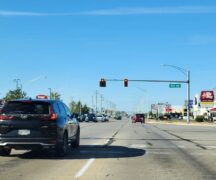By JAN McLAUGHLIN
BG Independent News
By a vote of 7-0, Bowling Green City Council squelched plans Monday evening to increase the speed limit on Ohio 25 to 60 mph on the northern edge of the city.
That means the speed limit between Newton and Bishop roads will remain 50 mph – at least for now.
Earlier this year, the Ohio Department of Transportation was reviewing speed limits and noticed a discrepancy in the journalized speed and posted speed limit signs on North Main Street from Parkview Drive to Bishop Road.
The journalized speed limit for this segment of road was set at 45 mph in 1996. The city currently has posted speeds of 35 mph from Poe Road to the north driveway for Kroger, 45 mph from Kroger to Newton Road, and 50 mph from Newton Road to Bishop Road. North of Bishop Road, outside city limits, the speed limit goes up to 60 mph.
Statutory speed limits can only be changed by ordinance or speed study. The city conducted a speed study, with the data suggesting the following recommendations for North Main Street:
- 35 mph speed zone remain unchanged from Poe Road to the north driveway of Kroger.
- 45 mph speed zone remain unchanged from Kroger north driveway to Newton Road.
- 60 mph speed zone replace the 50 mph zone from Newton Road to Bishop Road.
But concerns about bumping up the speed limit were voiced by council members Jeff Dennis and Bill Herald.
Both noted factors not included in the speed study which they said should be considered. Those include the new $550 million Abbott Laboratory plant being located at Route 25 and Nims Road, a $3.6 million shared use path being constructed up North Main Street to the plant, a stoplight planned at Nims Road, and the presence of a school at Dayspring.
Herald suggested the city possibly perform a new speed study in that area once the Abbott Labs facility is operating.
But right now, there are too many unknowns, he said.
Dennis pointed out concerning factors mentioned at a November City Council meeting by ODOT District Traffic Engineer Chris Waterfield.
Dennis asked about the likelihood of more accidents on that stretch of road if the speed limit is increased. Waterfield replied that the frequency of crashes won’t change, but the seriousness would.
“Crash severity will increase,” Waterfield said.
According to Dennis, the likelihood of a crash being fatal doubles when speed increases from 50 mph to 60 mph and death is 4 times more likely when speed increases from 50 to 70 mph.
Dennis also pointed out that in addition to putting lives at greater risk, more severe crashes will result in an increased burden on city safety services – at a time when BG Fire Division has just experienced its busiest three months since at least 2018.





